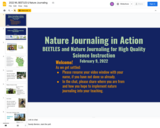
Running Slide Deck from WL BEETLES & Nature Journaling Online Sessions
- Subject:
- Environmental Literacy and Sustainability
- Material Type:
- Learning Task
- Author:
- Tiffany Lodholz
- skylar primm
- Sandy Benton
- Date Added:
- 02/09/2022

Running Slide Deck from WL BEETLES & Nature Journaling Online Sessions
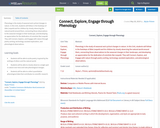
Phenology is the study of seasonal and cyclical changes in nature. In this Unit, students will follow in the footsteps of Aldo Leopold and his children by closely observing the natural world around them, connecting those observations to the seasonal changes in their landscape, and developing an appreciation for the dedication of scientists like Leopold. They will Connect, Explore, and Engage with nature through poetry writing, technology-assisted exploration, and phenological observations.

This resource will allow you to teach the concept of Farm to Table to your students as well as providing them with the understanding of the agricultural industry and how it connects us all together, and how it plays a role in their everyday lives.
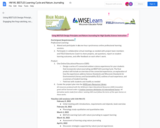
Overview of the project with requirements, timeline, and stipends.

Maple Grove Charter School, Athens School District, is a Grades K-5 elementary school located the heart of the rural Town of Hamburg. The school takes its name from the school forest on its site. Built in 1904, the school has annual tradition of tapping the maple trees. What started as a first grade classroom project has expanded as students from each grade level identify, tap, and collect sap from two trees. Unit plans have been created for each grade level to address agriculture, science, literacy, social studies, math, and environmental literacy standards. While the sap collecing routines remain relevatively constant each year, the learning opportunties have been differentiated by grade level so that students are always learning new content and skills.In the following unit plan discussion readers will learn about the schoolwide project from the perspective of teachers in Grades 1 and 5.Students in Grade 1 learn about maple tree identification and the traditional and modern tools and technologies employed in sap collection and syrup production. Their fifth grade counterparts continue to grow in their understanding of the tapping, collection, and production processes, and take on the role of entrepreneurs as they develop their brand and market the finished pure maple syrup.
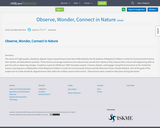
This series of 5 high-quality, standards-aligned, inquiry-based lessons have been field-tested by the 4K students of Wequiock Children's Center for Environmental Science, their teacher and educational assistant. These lessons encourage students to use natural areas around their school as they improve their science and engineering skills as part of a unit on observing changes. Created as a part of a WISELearn OER Innovation project, Connect, Explore, and Engage: Using the Environment as the Context for Science Learning was a collaboration of the Wequiock Children's Center for Environmental Science and the Wisconsin Green Schools Network. One of the goals of the project was to create standards-aligned lessons that utilize the outdoor spaces of the school . These lessons were created to take place during late winter.

Students are tasked with selecting an outdoor activity that they would like to engage in for at least 20 minutes every week over the course of the semester and reflect upon their experiences before, during and after the activity. For example, they might choose to go for a walk, seek out a hike in different parks each week, relax by the lake, or go for a swim.
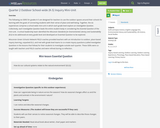
The following six OERS for grades K-5 are designed for teachers to use the outdoor spaces around their schools for learning with the goals of connecting students with their sense of place and well-being. Together, the six experiences comprise a school-wide mini-unit in which each grade level explore an Investigative Question. Collectively, each Investigative Question leads the entire student body in considering the Essential Question of the mini-unit. A school leadership team identified the Wisconsin Standards for Environmental Literacy and Sustainability (ELS) to be addressed at every grade level and developed an Essential Question to be explored.Wisconsin Green Schools Network FIELD coaches provided teachers with an introduction to outdoor, place-based inquiry learning, unpacked ELS, and met with grade level teams to co-create inquiry questions (called Investigative Questions in the lessons that follow) for their students to investigate outside each quarter. These OERs were co-taught with teachers and FIELD coaches and were refined during co-reflection.
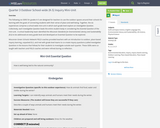
The following six OERS for grades K-5 are designed for teachers to use the outdoor spaces around their schools for learning with the goals of connecting students with their sense of place and well-being. Together, the six experiences comprise a school-wide mini-unit in which each grade level explore an Investigative Question. Collectively, each Investigative Question leads the entire student body in considering the Essential Question of the mini-unit. A school leadership team identified the Wisconsin Standards for Environmental Literacy and Sustainability (ELS) to be addressed at every grade level and developed an Essential Question to be explored.Wisconsin Green Schools Network FIELD coaches provided teachers with an introduction to outdoor, place-based inquiry learning, unpacked ELS, and met with grade level teams to co-create inquiry questions (called Investigative Questions in the lessons that follow) for their students to investigate outside each quarter. These OERs were co-taught with teachers and FIELD coaches and were refined during co-reflection.
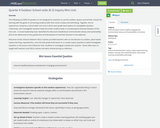
The following six OERS for grades K-5 are designed for teachers to use the outdoor spaces around their schools for learning with the goals of connecting students with their sense of place and well-being. Together, the six experiences comprise a school-wide mini-unit in which each grade level explore an Investigative Question. Collectively, each Investigative Question leads the entire student body in considering the Essential Question of the mini-unit. A school leadership team identified the Wisconsin Standards for Environmental Literacy and Sustainability (ELS) to be addressed at every grade level and developed an Essential Question to be explored.Wisconsin Green Schools Network FIELD coaches provided teachers with an introduction to outdoor, place-based inquiry learning, unpacked ELS, and met with grade level teams to co-create inquiry questions (called Investigative Questions in the lessons that follow) for their students to investigate outside each quarter. These OERs were co-taught with teachers and FIELD coaches and were refined during co-reflection.
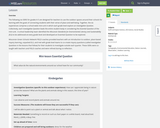
The following six OERS for grades K-5 are designed for teachers to use the outdoor spaces around their schools for learning with the goals of connecting students with their sense of place and well-being. Together, the six experiences comprise a school-wide mini-unit in which each grade level explore an Investigative Question. Collectively, each Investigative Question leads the entire student body in considering the Essential Question of the mini-unit. A school leadership team identified the Wisconsin Standards for Environmental Literacy and Sustainability (ELS) to be addressed at every grade level and developed an Essential Question to be explored.FIELD Edventures educators provided teachers with an introduction to outdoor, place-based inquiry learning, unpacked ELS, and met with grade level teams to co-create inquiry questions (called Investigative Questions in the lessons that follow) for their students to investigate outside each quarter. These OERs were co-taught with teachers and FIELD educators and were refined during co-reflection.

This recording from February 16, 2022 will enable viewers to learn alongside Skylar Primm, advisor and co-lead teacher of High Marq Environmental Charter School, Montello, WI as we explore ways to incorporate phenology studies along with nature journaling for science instruction.

Do you use nature journaling in your instruction? What evidence do students' journal entries provide on what they have learned and where they need to go next in their learning journeys?
In this session, we will: connect with experts and resources on nature journaling; explore practices to give students agency in their learning through self-assessment and peer feedback; and offer ways to improve deliberate practice to grow ideas and approaches.
New resources for nature journaling as well as the How to Teach Nature Journaling book.
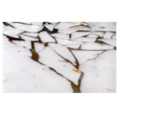
The is the recording of the online collaboration of the BEETLES and Nature Journaling WISELearn Group collaboration on March 2, 2022.
Slight shifts in lesson structures can meaningfully engage learners inequitable and culturally-relevant inquiries. Experience instruction in ways that people really learn and share your ideas for implementation. Come prepared with a nature journal or paper, pencils, and colored pencils as you view and participate in these recorded experiences.
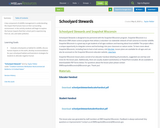
A key component of wildlife management is understanding the impact that humans have on their surrounding environment. In this activity students will begin to explore the human impacts that their school yard is experiencing from air, soil, and water pollution.
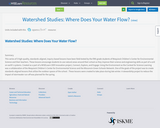
This series of 5 high-quality, standards-aligned, inquiry-based lessons have been field-tested by the fifth grade students of Wequiock Children's Center for Environmental Science and their teachers. These lessons encourage students to use natural areas around their school as they improve their science and engineering skills as part of a unit on earth's systems. Created as a part of a WISELearn OER Innovation project, Connect, Explore, and Engage: Using the Environment as the Context for Science Learning was a collaboration of the Wequiock Children's Center for Environmental Science and the Wisconsin Green Schools Network. One of the goals of the project was to create standards-aligned lessons that utilize the outdoor spaces of the school . These lessons were created to take place during late winter. A stewardship project to reduce the impact of stormwater run-off was planned for the spring.
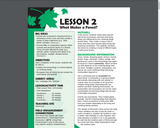
NUTSHELL: In the optional Field Enhancement portion of the lesson, the class explores the living and nonliving parts of a forest while on a hike. Students spend individual quiet time observing and drawing parts of a forest. In main portion of the lesson, students match plant species with forest ecosystems and learn that living things are influenced by the nonliving things around them. They create a song or skit to show what they have learned about living and nonliving connections. The students conclude the lesson by creating a mural of different types of Wisconsin forests.
BIG IDEAS
Forests are ecosystems characterized by a dominance of tree cover and they contain a variety of other organisms (e.g., other plants, animals).Forests differ in composition (species within a forest) and structure (layers in a forest). These are both affected by biotic (e.g., animals, plants, humans) and abiotic (e.g., soil moisture, sunlight, climate) factors.Â
OBJECTIVES Upon completion of this lesson, students will be able to:
Explain how living things in a forest depend on nonliving things.Recognize that all forests do not contain the same plants and animals.
SUBJECT AREAS: Arts, Language Arts, Science
LESSON/ACTIVITY TIME
Total Lesson Time: 190 minutes (including optional Field Enhancement)Time Breakdown: Field Enhancement (optional)--50 minutes; Introduction--15 minutes; Activity 1--35 minutes; Activity 2--45 minutes; Conclusion--45 minutes
TEACHING SITE Classroom; well-forested site for optional Field Enhancement
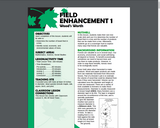
NUTSHELL In this highly interactive lesson, students explore the tools used by foresters to measure tree diameter and height, then calculate the number of board feet in a tree and the number of products that can be made from that tree. Afterwards, students go on a scavenger hunt to explore many ways that forests are valuable.
OBJECTIVES Upon completion of this lesson, students will be able to:
Determine the number of board feet in a tree.Identify social, economic, and environmental values of trees.
SUBJECT AREAS Mathematics, Science, Social Studies
LESSON/ACTIVITY TIME
Total Lesson Time: 150 minutes (not including optional add-on lesson)Time Breakdown: Pre-activity--60 minutes; Introduction--10 minutes; Activity 1--40 minutes; Activity 2--30 minutes; Conclusion--10 minutes (Optional classroom lesson "We All Need Trees--90 minutes)
TEACHING SITE:Â A wooded area with trees at least 10 inches in diameter. Ideal species include maple, oak, aspen, birch, and pine.